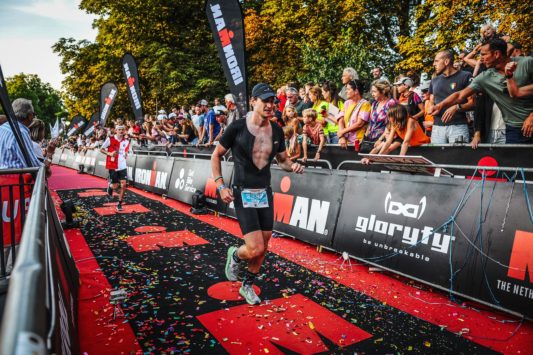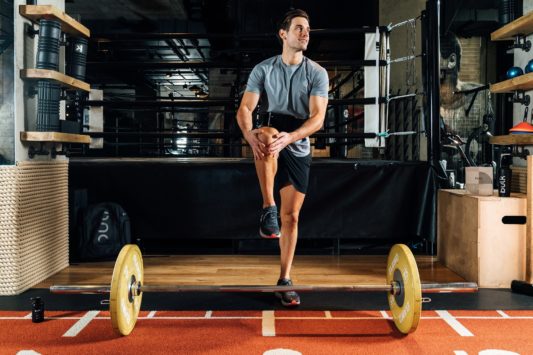There’s a common misconception in fitness culture that muscle growth and running are not compatible. The myth is based on the idea that if you want a muscular, strong physique, you shouldn’t run because it will eat into your muscle gains.
Well, that’s not the case, and we’re here to explain why it is possible to build muscle mass and run at the same time. But not only that, we’ll explain how to do it too.
Let’s go.
What’s the short answer?
Yes. You can build muscle and run at the same time. Although some studies suggest that concurrent training makes it more difficult to grow muscle (1), it is still very much possible. Close attention must be paid to resistance training, runs and nutrition in order to get the desired results.
If your primary goal is to build as much muscle as possible, incorporating running may not be the optimal way to do this. However, if you want a balanced, healthy, aesthetic and functional body, adding running to your training programme alongside resistance training is a great idea.
Does running build muscle?
Technically, yes. Running builds muscle in your legs. During running training you are adding resistance to your legs with every step – think of it like a really long set in the gym, with hundreds of reps at a really lightweight. You stimulate your glutes, hamstrings, quads and calves (especially calves). This is enough to maintain – or even build – muscle mass in your legs. However, this is nowhere near the mass you would build while doing specific leg exercises such as squats, leg extensions and leg press.
What could prevent muscle building and running?
It would be inaccurate to suggest that running has no effect on building muscle. Of course, it has some impact. But it’s important to put it into perspective. The physique of a professional runner is typically lean, so bodybuilders assume they’d lose all of their muscle if they were to start running. Is this really true, though?
Let’s switch this idea around. A bodybuilder’s physique is typically very muscular and sometimes bulky (depending on the season). Imagine a marathon runner looking at this physique and thinking they could achieve that with a few trips to the gym. You’d think that was pretty foolish right? That’s because you understand that building that amount of muscle takes years and years of hard work and gin in the gym – you don’t just lift a few dumbbells and turn into Arnold Schwarzenegger overnight.
But guess what? The exact same thing applies to a runner’s physique. Just like you won’t turn into Arnold with a few sets of bicep curls, you won’t turn into Mo Farah after a few jogs in the park. So relax. As long as you continue giving your muscles adequate stimulus through resistance training and maintain solid nutrition, your hard-earned muscle won’t be deserting you any time soon.
That being said, it is slightly inaccurate to suggest that running has absolutely zero impact on building muscle. It does. So let’s talk about that a little.

The interference effect
The interference effect is the phenomenon by which adaptation to concurrent strength training and endurance training is diminished compared to separately training only strength or endurance (2). In other words, muscle training and endurance training interfere with each other when trained together, either in the same session or on the same day.
But in terms of a committed gym-goer, what does this mean? How much attention do we need to pay to it? This piece of research (2) pulled the results of 13 studies and found that placing cardio immediately prior to resistance training resulted in decreased improvements in strength. They also discovered that resistance training is compromised for around 6-8 hours after endurance training, depending on the length and intensity (whether it was a one-mile run or 10 miles, for example). However, it’s also worth noting here that studies suggest the interference effect is more of a concern for advanced trainees, rather than beginners (3).
You may have noticed there is a solution to avoiding the interference effect directly – train them on different days. Yes, that’s right. For strength development, studies have found there is no significant interference effect when trained subjects split their endurance and resistance training into separate training sessions (3). This means it’s a great option when it comes to creating a functional hybrid training programme.

However, for people whose goal is to build as much muscle as possible, it’s inevitable that splitting your training into different days will affect your progress in other ways. This is because reducing your sessions in the gym (from five to three, for example) will result in less total volume, and thus less stimulus causing the muscles to adapt and grow. And this is also assuming that you’re maintaining a calorie surplus, something difficult (but very possible) to achieve when expending calories on consistent endurance training.
So yes, running may affect your ability to grow muscle at a maximally optimal rate. But this doesn’t mean you can’t build muscle at all while running. You most certainly can. To reiterate, the interference effect has been shown to have no significant effect on untrained individuals, and only a marginal effect on advanced trainers. So unless you’re stepping on the stage at Mr Olympia anytime soon, you probably don’t need to worry.
How to run and build muscle at the same time
Nutrition
A vital aspect of muscle growth is a calorie surplus. With frequent endurance training, getting in the necessary calories to build muscle is often one of the biggest challenges. This is where using supplements like protein powders is especially useful, as it allows you to significantly increase your protein intake with the convenience of a high-quality (and delicious, of course) shake.
Meal timing is also crucial. Prior to a workout, you need adequate levels of glycogen to perform at your best. This is because glycogen is the body’s primary energy source for exercising in higher intensity runs (like a race pace), and is stored when we consume carbohydrate. Essentially, fueling up with carbs before running sessions are super important for maintaining physical performance (4).
Think fast-absorbing carbs like bananas, overnight oats and tasty bowls of pasta. Sometimes it’s difficult to prepare such meals in advance, which is why having convenient and fast ways to fill up your glycogen stores before a run or heavy workout is necessary. Highly Branched Cyclic Dextrin is a great option for this (as recommended in our marathon running advice blog).
Also, as outlined in our guide on how to train for an Ironman, another avenue worth exploring is intra-workout supplements. Incorporating mid-workout nutrition is relatively straightforward for gym work, as you can take sips of your drink throughout. For long-running sessions, this could be in the form of gels or a Hydration Drink.

Progressive Overload
Progressive overload is a top priority when it comes to building muscle mass. This is the need to continuously increase training volume, forcing our muscles to grow. The more we train, the more adapted we become, so increasing volume keeps our muscles challenged and encouraged to grow larger and stronger in order to keep up with the demand.
If your aim is muscle building (rather than muscle maintenance), it’s important to ensure your programme has progressive overload built in. The easiest way to do this, in terms of tracking, is to progressively increasing the weight over time, but the intensity (weight) is only one variable we can manipulate to create a higher training volume. There are also reps, sets and even tempo.
Time your sessions wisely
As mentioned before, consider the Interference effect and how you want to get around it. This can either be by separating your concurrent training into different days, or by spacing them out as much as possible by doing one in the morning and another in the evening.
Separating sessions on different days will discount the interference effect altogether, but could result in less overall volume. Try both methods of concurrent training and see which works best for you.
Change your mindset
The long-standing myth around running and muscle building has tainted the fitness industry for years. You don’t have to buy into it. Why? Not only does the science suggest otherwise, but you’ll find thousands of practical examples of real people doing it.
You’ll discover numerous content creators proving building and running are compatible. Nick Bare, for example, has a whole series about the ‘Hybrid Build’ in which he preaches power concurrent training. Having recently completed a sub-2:50 marathon at 196lbs, Bare is a living and breathing example of what is possible when it comes to concurrent training. Tell him you can’t run and build muscle at the same time.
There’s also Alan Thrall – a powerlifting specialist with a passion for running. He puts into perspective how the average gym-goer, running is an incredible tool to provide balance and richness to your training programme.

Practical routine examples
To help you visualise how to incorporate running and muscle building into your routine, let’s cover two examples. Person A is a runner looking to add resistance training into their routine, while Person B is a ‘lifter’ looking to run but still maintain or build their physique.
Person A – Runner looking to build muscle
This is if your main ambition is to grow muscle, but you love running and want to keep it in your programme.
The first thing you’ll need to decide is whether you want to run and train on the same days, or separate your training into different days. If you want to double up with a gym session and a run on the same day, it would be better to do resistance training first and then run after. This decreases interference.
But let’s say you want to avoid the interference effect altogether, and train only one method per day. To do this, split your training into either four gym sessions and two running, or three and three. This gives you the opportunity to vary the sessions in both your endurance (with long runs and intervals) and resistance training (upper-body and lower-body days).
With consistent training, progressive overload and a solid nutrition plan in a calorie surplus, there’s every chance you will build muscle while maintaining your endurance. With the extra calories from the running sessions, nutrition is a massive focus here. Get those calories in post-workout, prioritising your overall protein intake.
Person B – Lifter looking to begin running (while maintaining or building muscle)
You are a regular gym-goer but want to add running to your programme. This could be for the general exercise benefits for mental health, or it could you’re raining for a Marathon, Half arathon or 10k. You need to run, but don’t want to stop resistance training entirely.
Since running performance is your priority, let’s say you’re running three to four times per week. To fit in adequate resistance training, you’re probably going to want to train three times. This is seven days a week, which is probably too much for most people. In order to fit in at least one rest day, you have to train on the same day once or twice. Spread out the sessions as far as possible in order to minimise interference.
In terms of the sessions themselves, full-body sessions could be a good way to get the best bang for your buck, especially if you find yourself only resistance training twice.
As with Person A, nutrition is paramount here. If you don’t have the right fuel for your sessions, you’ll burn out pretty quickly. So focus on your nutrition and ensure you’re getting quality calories in.
For a more detailed example of a similar routine, check out Thrall’s insightful five-day programme. This programme allows you to increase your one-mile and deadlift PB at the same time.
So, does running burn muscle?
As one of the best exercises for mental health, running is a great activity to add to your routine. While this article focused on explaining how to build muscle and run, it also implies that you can also maintain muscle and run at the same time. If you are someone who has built up muscle mass over some years of training, maintaining that muscle and turning it into something functional is a viable and worthwhile goal.
But keep in mind that you don’t need to be stressed about tangible progression every week. Going slow is absolutely okay. Focus on the freeing, refreshing aspect of training, and remember to train for the love of it. Whether it’s getting up at dawn for a morning run, or entering a busy evening gym to pull some deadlifts, exercise is a beautiful privilege. Sometimes it’s worth taking a step back and appreciating the activity for what it really offers – fun, fulfilment and enjoyment.
We believe in encouraging everyone to find their passion for exercise. For more fitness content check out @bulk for recipes, ambassador workouts and gym tips and join our community of fitness lovers and foodies.
Related articles
Eager to learn more? We believe that every person, with support, has the right to transform their lives through fitness. That’s why we’ve put together hundreds of articles with expert advice, all to help you on your fitness journey.
Stretches for runners Weight training for boxing
Best food for runners Add running to your routine
How to train for an Iron Man Does alcohol effect your recovery from training?
What is dorsiflexion? Holiday workouts for abs, fat loss and muscle growth
Nutrition for endurance training Supplements for endurance
What to eat before a run Should you take pre-workout before cardio?














